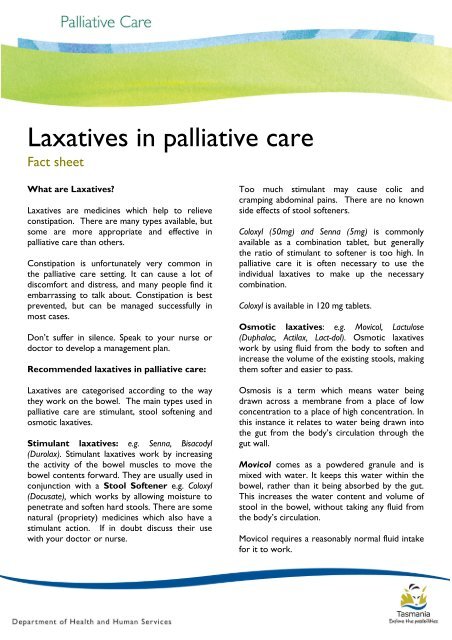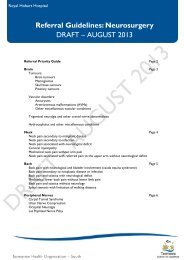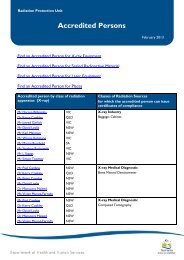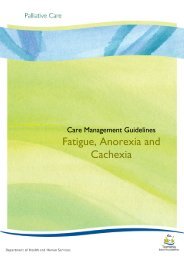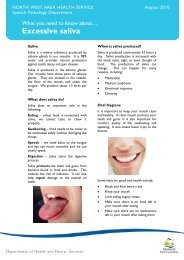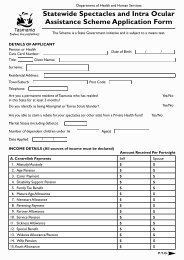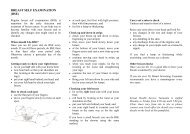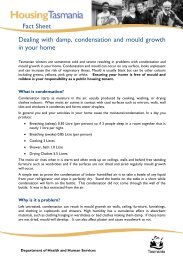About laxatives in palliative care
About laxatives in palliative care
About laxatives in palliative care
You also want an ePaper? Increase the reach of your titles
YUMPU automatically turns print PDFs into web optimized ePapers that Google loves.
Laxatives <strong>in</strong> <strong>palliative</strong> <strong>care</strong><br />
Fact sheet<br />
What are Laxatives?<br />
Laxatives are medic<strong>in</strong>es which help to relieve<br />
constipation. There are many types available, but<br />
some are more appropriate and effective <strong>in</strong><br />
<strong>palliative</strong> <strong>care</strong> than others.<br />
Constipation is unfortunately very common <strong>in</strong><br />
the <strong>palliative</strong> <strong>care</strong> sett<strong>in</strong>g. It can cause a lot of<br />
discomfort and distress, and many people f<strong>in</strong>d it<br />
embarrass<strong>in</strong>g to talk about. Constipation is best<br />
prevented, but can be managed successfully <strong>in</strong><br />
most cases.<br />
Don’t suffer <strong>in</strong> silence. Speak to your nurse or<br />
doctor to develop a management plan.<br />
Recommended <strong>laxatives</strong> <strong>in</strong> <strong>palliative</strong> <strong>care</strong>:<br />
Laxatives are categorised accord<strong>in</strong>g to the way<br />
they work on the bowel. The ma<strong>in</strong> types used <strong>in</strong><br />
<strong>palliative</strong> <strong>care</strong> are stimulant, stool soften<strong>in</strong>g and<br />
osmotic <strong>laxatives</strong>.<br />
Stimulant <strong>laxatives</strong>: e.g. Senna, Bisacodyl<br />
(Durolax). Stimulant <strong>laxatives</strong> work by <strong>in</strong>creas<strong>in</strong>g<br />
the activity of the bowel muscles to move the<br />
bowel contents forward. They are usually used <strong>in</strong><br />
conjunction with a Stool Softener e.g. Coloxyl<br />
(Docusate), which works by allow<strong>in</strong>g moisture to<br />
penetrate and soften hard stools. There are some<br />
natural (propriety) medic<strong>in</strong>es which also have a<br />
stimulant action. If <strong>in</strong> doubt discuss their use<br />
with your doctor or nurse.<br />
Too much stimulant may cause colic and<br />
cramp<strong>in</strong>g abdom<strong>in</strong>al pa<strong>in</strong>s. There are no known<br />
side effects of stool softeners.<br />
Coloxyl (50mg) and Senna (5mg) is commonly<br />
available as a comb<strong>in</strong>ation tablet, but generally<br />
the ratio of stimulant to softener is too high. In<br />
<strong>palliative</strong> <strong>care</strong> it is often necessary to use the<br />
<strong>in</strong>dividual <strong>laxatives</strong> to make up the necessary<br />
comb<strong>in</strong>ation.<br />
Coloxyl is available <strong>in</strong> 120 mg tablets.<br />
Osmotic <strong>laxatives</strong>: e.g. Movicol, Lactulose<br />
(Duphalac, Actilax, Lact-dol). Osmotic <strong>laxatives</strong><br />
work by us<strong>in</strong>g fluid from the body to soften and<br />
<strong>in</strong>crease the volume of the exist<strong>in</strong>g stools, mak<strong>in</strong>g<br />
them softer and easier to pass.<br />
Osmosis is a term which means water be<strong>in</strong>g<br />
drawn across a membrane from a place of low<br />
concentration to a place of high concentration. In<br />
this <strong>in</strong>stance it relates to water be<strong>in</strong>g drawn <strong>in</strong>to<br />
the gut from the body’s circulation through the<br />
gut wall.<br />
Movicol comes as a powdered granule and is<br />
mixed with water. It keeps this water with<strong>in</strong> the<br />
bowel, rather than it be<strong>in</strong>g absorbed by the gut.<br />
This <strong>in</strong>creases the water content and volume of<br />
stool <strong>in</strong> the bowel, without tak<strong>in</strong>g any fluid from<br />
the body’s circulation.<br />
Movicol requires a reasonably normal fluid <strong>in</strong>take<br />
for it to work.
Lactulose (Duphalac, Actilax, Lact-dol) are<br />
concentrated complex sugar solutions which are<br />
broken down by the bacteria that live <strong>in</strong> the<br />
lower part of the gut. This leads to the contents<br />
of the gut becom<strong>in</strong>g more acidic, which reduces<br />
the absorption of a chemical called ammonia. The<br />
presence of ammonia <strong>in</strong> the gut causes water to<br />
be drawn <strong>in</strong>to the lower bowel. This <strong>in</strong>creases<br />
the amount of water <strong>in</strong> the stools, soften<strong>in</strong>g them<br />
and mak<strong>in</strong>g them easier to pass. It can take 48<br />
hours to have an effect.<br />
These <strong>laxatives</strong> are primarily useful for people<br />
who can dr<strong>in</strong>k at least two litres of liquid a day. If<br />
there is not enough fluid <strong>in</strong> a person’s system the<br />
complex sugars ferment and create w<strong>in</strong>d and<br />
bloat<strong>in</strong>g, which can cause pa<strong>in</strong>ful colic.<br />
Be regular to keep regular<br />
Hav<strong>in</strong>g to take regular medications to make what<br />
used to happen automatically might seem like a<br />
bother. However, keep<strong>in</strong>g to a rout<strong>in</strong>e of<br />
monitor<strong>in</strong>g your bowel habits, and adjust<strong>in</strong>g the<br />
<strong>laxatives</strong> as needed, will keep you regular, add<strong>in</strong>g<br />
to your comfort and well-be<strong>in</strong>g, mak<strong>in</strong>g the effort<br />
worthwhile.<br />
Other commonly available <strong>laxatives</strong><br />
Bulk form<strong>in</strong>g <strong>laxatives</strong><br />
Bran, Normacol, Fybogel, Metamucil, Nulax, Psyllium<br />
husks<br />
These <strong>laxatives</strong> work by swell<strong>in</strong>g when they come<br />
<strong>in</strong>to contact with fluid, <strong>in</strong>creas<strong>in</strong>g the amount of<br />
stool and encourag<strong>in</strong>g the bowel to push the<br />
stools forward and out.<br />
They can take a few days to work properly and<br />
are ideal for people who are healthy and active,<br />
and can dr<strong>in</strong>k large amounts of water.<br />
They have limited use <strong>in</strong> the <strong>palliative</strong> <strong>care</strong> sett<strong>in</strong>g<br />
as most people are unable to dr<strong>in</strong>k sufficient fluid<br />
and the bulk form<strong>in</strong>g <strong>laxatives</strong> can end up stick<strong>in</strong>g<br />
to the <strong>in</strong>side of the bowel, caus<strong>in</strong>g obstruction.<br />
Other <strong>laxatives</strong> which are commonly available but<br />
not generally recommended <strong>in</strong>clude<br />
liquid parraf<strong>in</strong> (Agarol);<br />
Magnesium salts (Epsom salts);<br />
Parachoc; and<br />
Oral Fleet and colonLYTELY<br />
(preparations used before bowel<br />
<strong>in</strong>vestigations or surgery).<br />
Ford pills, Laxettes and other proprietary<br />
(trademark) medications are generally not<br />
effective for <strong>palliative</strong> <strong>care</strong> needs except <strong>in</strong> doses<br />
that are toxic, add<strong>in</strong>g to overall discomfort.<br />
Suppositories and Enemas<br />
Suppositories and enemas are used when there is<br />
a hard stool which is sitt<strong>in</strong>g down low <strong>in</strong> the<br />
rectum. Sometimes it is necessary to move this<br />
hard plug with lubrication such as a glycer<strong>in</strong><br />
suppository before <strong>in</strong>creas<strong>in</strong>g oral <strong>laxatives</strong>.<br />
Microlax enemas are also useful <strong>in</strong> empty<strong>in</strong>g the<br />
rectum.<br />
When to call the doctor or nurse<br />
If you are hav<strong>in</strong>g difficulty ma<strong>in</strong>ta<strong>in</strong><strong>in</strong>g a<br />
regular bowel pattern and are suffer<strong>in</strong>g<br />
discomfort; or<br />
If you have constipation with severe<br />
abdom<strong>in</strong>al cramp<strong>in</strong>g pa<strong>in</strong> and vomit<strong>in</strong>g (do<br />
not take <strong>laxatives</strong>).<br />
Related Fact Sheets<br />
Constipation<br />
CONTACT DETAILS<br />
Palliative Care South<br />
Ph: 03 6224 2515 or <strong>palliative</strong><strong>care</strong>.south@dhhs.tas.gov.au<br />
Palliative Care North<br />
Ph: 03 6336 5544 or <strong>palliative</strong><strong>care</strong>.north@dhhs.tas.gov.au<br />
Palliative Care North West<br />
Ph: 03 6440 7111 or <strong>palliative</strong><strong>care</strong>servicenw@dhhs.tas.gov.au<br />
Developed May 2009 Page 2 of 2


